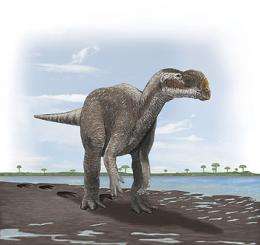Australia’s biggest carnivorous dinosaur forced to take a walk

(PhysOrg.com) -- Doubt has been cast over the only known piece of evidence that large carnivorous dinosaurs once roamed Australia, following new research by The University of Queensland (UQ).
A set of footprints at Lark Quarry Conservation Park, south of Winton in central-western Queensland, was the only evidence that Australia was once home to large carnivorous theropod dinosaurs as big as Tyrannosaurus rex or Allosaurus fragilus.
For the past 30 years, these footprints were believed to show a large meat-eating dinosaur chasing a herd of smaller dinosaurs. The site is world famous as it is also thought to be the only example of a dinosaur stampede.
However, a new study by palaeontologists from UQ has shown that these tracks probably don't belong to a large theropod at all, and were most likely left by a large herbivore akin to Muttaburrasaurus.
UQ's School of Biological Sciences PhD candidate, Anthony Romilio, led the research, which has been published in the latest issue of the journal Cretaceous Research.
Mr Romilio made the discovery after comparing the lengths and other characteristic measurements of the famous footprints.
“Making the distinction between the three-toed tracks of herbivorous ornithopod dinosaurs and the three-toed tracks of carnivorous theropod dinosaurs can be quite difficult,” Mr Romilio said.
“This confusion has lead to numerous ornithopod dinosaur tracks being incorrectly identified as belonging to theropods, and vice versa.
“Since 1979, the large three-toed tracks at Lark Quarry have been regarded as being similar to Tyrannosauropus footprints from the US.
“As the name implies, these tracks were thought to have been made by T. rex. But in 1994 it was shown that they most likely belonged to a large ornithopod dinosaur, not a theropod,” Mr Romilio said.
“Ironically, these were probably similar to the dinosaurs upon which T. rex preyed.”
The UQ researchers took measurements from all eleven footprints at Lark Quarry and compared the shape with other ornithopod and theropods footprints from around the world.
Threshold values for specific foot proportions enabled them to distinguish between the tracks made by each type of dinosaur.
“The footprint analysis shows overwhelmingly that the Lark Quarry tracks were made by an ornithopod dinosaur,” Mr Romilio said.
“The best preserved prints show a remarkable similarity in overall size, shape and claw outline to ornithopod tracks from Canada named Amblydactlyus gethingi. These features mean that we need to re-name the large Lark Quarry tracks Amblydactlyus cf. A. gethingi.
“The footprints were probably made by a large ornithopod, standing over 2.5 metres tall at the hips. The claw impressions indicate that it was one of the more primitive members of this dinosaur group. Based on the age and location of Lark Quarry, we propose that the track-maker may have been a dinosaur similar to Muttaburrasaurus langdoni.”
Fossils of Muttaburrasaurus are known from similarly aged rocks near Muttaburra and Hughenden, both of which are only a few hundred kilometres from Lark Quarry.
Mr Romilio's supervisor, Dr Steve Salisbury, said the previous identification of the Lark Quarry tracks as belonging to a T. rex- or Allosaurus-sized predator was central to the interpretation of the track site as a stampede.
“The approach of the large dinosaur was thought to have triggered the stampede of 150-170 smaller dinosaurs across a mud flat nearly 100 million years ago,” Dr Salisbury said.
“Whether the presence of a large herbivore like Muttaburrasaurus was enough to spook a herd of smaller dinosaurs into a stampede is now unclear. Further research on the actual nature of the stampede itself is what we are now focusing on.”
Provided by University of Queensland


















